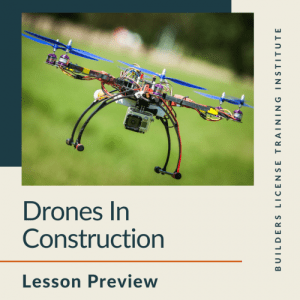Drones In Construction | Lesson Preview
Published on November 3, 2020 by Nate Bortz

If you're looking for a way to stay ahead of the competition, this course can help!
Our "Drones in Construction" continuing education courses are available in many states, and are designed to familiarize business owners with the practical uses of drone technology.
After Finishing The Course, You Will...
- Become knowledgeable about available technology and proper use of drones
- Gain familiarity with the use of UAV technology in your specific industry
- Learn the basics of aerial survey and mapping
- Decide if UAV technology is right for you and your business
- Know the FAA application process for an FAA 333 Exemption
- Learn about alternatives to owning your own drone
- Gain knowledge of FCC and FAA rules regarding UAV deterrent technology
- Learn the benefits of UAV application in marketing and advertising
If you're interested in learning more about how drones can help improve the accuracy of your surveying, mapping, measuring, and site scanning, take a look at this lesson preview!
Introduction — Lesson Preview
Drones are the new tool companies are raving about for their marketing and personal use. There are many potential uses for drones in the construction industry, but there are rules and regulations set in place that currently don't allow them. So why should you care? Because you need to stay up to date with technology and ahead of the competition.
This course is designed to familiarize business owners with the practical use of drone technology. The following topics will be discussed:
► Types of UAV/Drones in the Industry
► Federal Rules and Regulations associated with UAVs
► Cost of Drones (Pros and Cons)
► Drones in your Industry (overview)
What Type of Drone is Right for You?
Which is the right one? Ask yourself, what do you want your drone to do?
► Mapping and Surveying
► Site Monitoring
Be sure to research the different types, and how that applies to your business. Drones have different technology and different uses. Most people are interested in aerial imagery, and most drones are equipped with cameras. The cameras are of varying quality, some high definition, some low. Others carry camera rigs. Videos and still pictures are the primary reasons people purchase drones.
Drones use GPS technology and can be controlled manually, using a remote control with a joystick, via computer software from your desktop or laptop computer and — not surprisingly in our mobile era — they can be controlled via smart gadget apps as well. The combination of GPS, accelerometers, gyroscopes and position sensors, as well as the drones' main processors — allows them to be sent on specific, pre-programmed flight paths. When armed with cameras that yield both video and still photography, drones can be very effective surveillance tools.
OVERHEAD IMAGERY
There are cameras that can be attached to a drone to capture high-definition videos and still photos from overhead while flying. Traditionally, you would have to hire helicopters or planes to fly and capture overhead images. The images captured with your drone can be used to show your building progress, and then the finished product to customers and potential clients.
SURVEILLANCE
A popular use of drones in construction is to watch over contractors while they work. By doing this, you can ensure the proper health and safety guidelines are followed. Fly the drone to a fixed spot up high on a job site and land it to record the site at night to watch for trespassers and eliminate possible property damage. In the future, I think it would be great to give clients access to the images you're taking in a live stream. Then, they would be able to watch the building process happen and make sure everything is being done to their expectation.
CONDUCT AERIAL SURVEYS
Before starting a project, you can easily evaluate a site if you have a drone. Eliminate any preventable problems with the site before beginning excavation. For marketing purposes, use the drone to show images of the job's progress, capturing every stage of the project, "before and after". You can also compare the images captured with the drone to Google Maps to make calculations for the building you're constructing. Conducting aerial surveys will save time, money and resources since you won't have to hire out for helicopters and planes. Using drones could also be useful for places where space is limited, such as cities and subdivisions where planes and helicopters can't get as close to the ground.
Types:
► Fixed Wing. The first type of drone is a fixed wing. These look similar to a mini-airplane. Fixed wing drones can only fly in one direction — forward. They are ideal for aerial mapping and surveying. A remotely piloted vehicle is used by NASA researchers to conduct Earth science research. A fixed wing drone can typically stay in the air for about 45 to 90 minutes. Fixed wing drones can fly at 45 to 50 miles an hour and deliver high quality images.
► Rotary Blade. The second type is a rotary blade, or propeller-based system, like a helicopter. Unlike the fixed wing drones, quadcopters can hover and fly in any direction- horizontal, vertical and diagonal. Rotary blade drones have many propellers and are ideal for inspection work, or surveying hard to reach areas. Average time in the air is 18 to 20 minutes, depending on the battery. A quadcopter can fly anywhere between 20 and 25 miles per hour (but typically won't get the high resolution shots you want).
